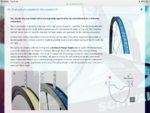Mtl_Biker
Active Member
I know absolutely nothing about tubeless wheels/tires on bicycles, but I'm seeing a lot of e-bikes that claim to be "tubeless ready". What exactly does that mean? Does it mean the tires have tubes in them but the tubes could be removed? Or that a whole new tire (tubeless) could be put onto that rim?
My experience with tube and tubeless tires is on motorcycles... I've had motorcycles with tubeless tires and have gotten punctures that were easy to repair (plug) on the road without even having to remove the wheel from the bike. And the plugs then lasted the rest of the life of the tire. And I've also had (and have now) a BMW GS with TUBE tires, where fixing a flat is a monstrous big job, especially when you're on a tour (and at night in the rain when you're alone). So on a motorcycle I'd much rather have tubeless tires.
But how does this work on bicycles? How do you fix a flat? Or do you carry a whole spare tire? And then with tubeless you've have to have a really high air pressure to seat the bead of the new tire... can bicycle pumps give high enough pressure for that?
So, what are the pros and cons of tubeless tires on bicycles?
Thanks for your comments.
My experience with tube and tubeless tires is on motorcycles... I've had motorcycles with tubeless tires and have gotten punctures that were easy to repair (plug) on the road without even having to remove the wheel from the bike. And the plugs then lasted the rest of the life of the tire. And I've also had (and have now) a BMW GS with TUBE tires, where fixing a flat is a monstrous big job, especially when you're on a tour (and at night in the rain when you're alone). So on a motorcycle I'd much rather have tubeless tires.
But how does this work on bicycles? How do you fix a flat? Or do you carry a whole spare tire? And then with tubeless you've have to have a really high air pressure to seat the bead of the new tire... can bicycle pumps give high enough pressure for that?
So, what are the pros and cons of tubeless tires on bicycles?
Thanks for your comments.


